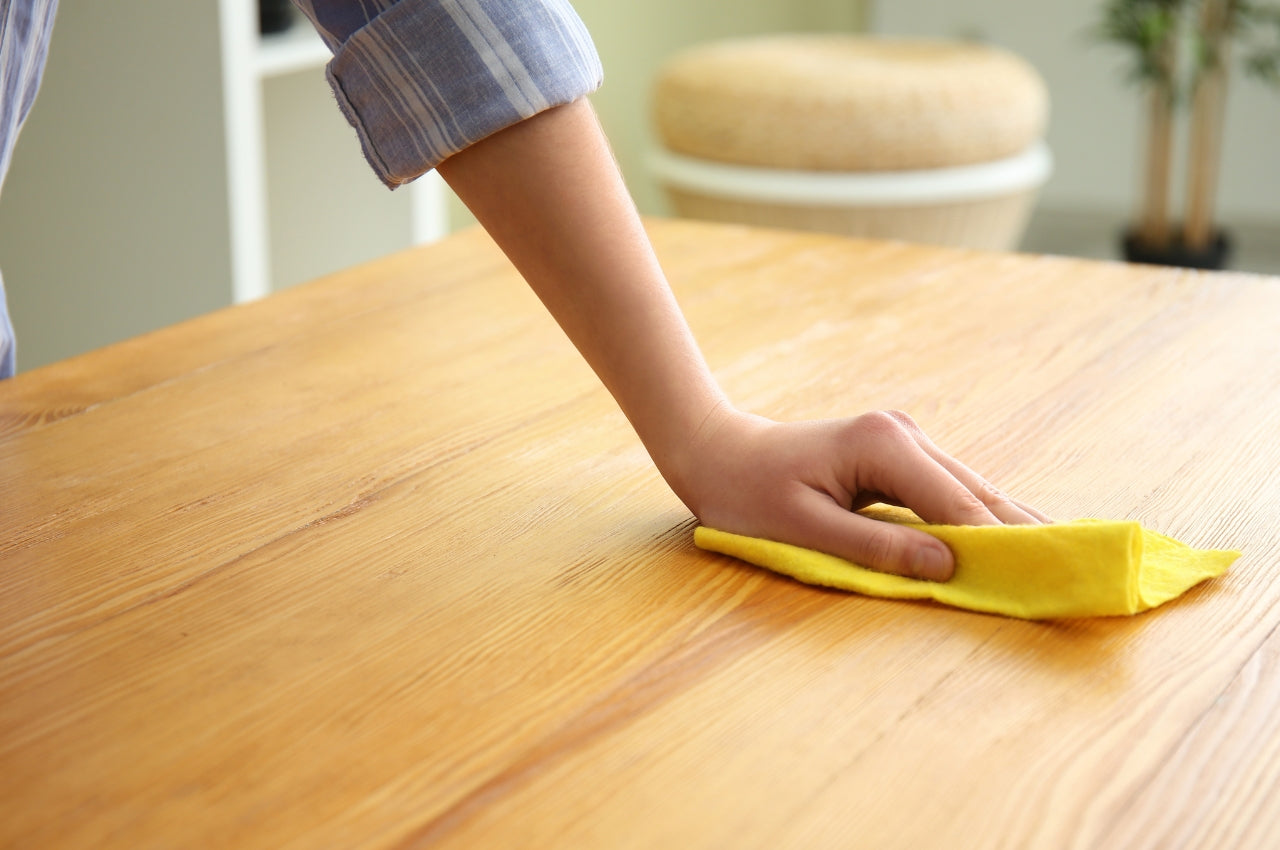The surface of your wood furniture tells a story. Those little scratches, dents, and faint water rings reveal the life it's lived—and yours, too. From time to time, though, we yearn for a fresh slate, especially in our home. We deep-clean and declutter our closets to make way for a new start. Some old stories have to fade into the background, which is why we polish and refinish our furniture to make it ready for the next chapter.
If you're looking to give your home office desk a quick refresh or breathe new life into a well-worn coffee table, read this guide. Here, we'll walk you through how to polish and refinish wood furniture.
When to Clean or Sand Wood Furniture
Before starting the task, take a closer look at your furniture and assess its condition. Does the surface appear dry, dull, and lightly scratched? Giving the piece a good cleaning and polishing might be all it needs.
However, if the furniture has deeper scuffs, cloudy watermarks, and feels rough to the touch, then it's time to consider sanding.
Here's a quick breakdown:
|
Signs You Need to Just Clean |
Signs You Need to Sand |
|
- Surface looks dry and dull - Minor surface scratches - No major discoloration - Finish is still intact |
- Peeling and cracked finish - Water and heat rings - Rough and raised patches - Deep and dark scuffs |
How to Clean and Polish Wood Furniture
Think of polishing furniture like a day in the spa. It's all about rejuvenation: restoring its luster, conditioning the wood, and offering it a fresh layer of protection.
Things You Need:
- Microfiber cloth, at least two
- Mild soap
- Water
- Wood oil
- White vinegar or steel (for stubborn dirt)
Instruction:
1. Clean the surface. Start by gently cleaning the piece to remove any dust and grime. Mix a few drops of mild soap in warm water. Dampen the soft cloth with this mixture and use it to wipe the surface. Make sure not to soak the wood. Dry immediately with a clean towel and allow it to air dry for a few minutes.
2. Remove stubborn residue (optional). For sticky and waxy buildup, white vinegar helps. Mix a solution of equal parts vinegar and water. Dampen a cloth and spot-test in an inconspicuous area. If there's no discoloration, proceed to clean the affected areas. Another option is to use a steel brush to clean stubborn dirt. Use both sparingly.
3. Apply wood oil. Use a clean cloth to apply a small amount of wood oil to the furniture. Rub it in gently, working in the direction of the grain. Allow the oil to soak for 30 minutes, then use a dry cloth to buff the surface.
How to Sand and Polish Wood Furniture
Sanding may require more time and elbow grease, depending on the area you need to work on. But the extra effort is worth it. It can give your furniture piece the fresh look it deserves.
Things You Need:
- Drop cloth or newspaper
- Sandpaper in different grits, coarse, medium, and fine
- Sanding block (optional but recommended)
- Tack cloth or vacuum with a brush attachment
- Wood oil or balm
Instruction:
1. Prepare your work area. Choose a well-ventilated space. Lay down a drop cloth or newspaper to catch the wood dust.
2. Inspect the furniture. Identify the deep scratches, water rings, and raised grain so you know where to focus sanding.
3. Start with the coarse grit. Wrap coarse sandpaper around a sanding block. Without a sanding block, simply fold the sandpaper in thirds. Sand the surface with the grain using steady, even strokes. Apply light to moderate pressure and let the paper do the work.
4. Move to medium grit. Once the problem areas are tackled and the surface is even, switch to a medium grit to smoothen coarse sanding marks. Wipe or vacuum away dust between each grit.
5. Finish with a fine grit. As a final step to make the surface smoother, sand it with fine grit. A finer surface is better at taking in the benefits of the wood balm or oil.
6. Check and remove all dust. Inspect the surface for any missed spots. Resand gently as needed. Once ready, remove any dust with a vacuum or a tack cloth. Clean thoroughly with a clean and dry cloth.
7. Apply wood balm or oil. Use a clean cloth to apply a small amount of wood oil or balm on the furniture. Rub it in gently, working in the direction of the grain. Allow 30 minutes for the oil or balm to penetrate the wood grain. Use a dry cloth to buff.
Refinishing the Natural Way or with Stain and Varnish
For best results, avoid commercial wood polish with silicone or petroleum-based ingredients. Use an organic wood oil or balm to revive the natural sheen of solid wood furniture. It also helps the material develop a beautiful, satin-like patina over time.
Staining can give the wood surface a fresher and brighter color. But it's harder to reverse if you decide to refinish and bring out the material's natural color later. It may also hide subtle wood details that make your furniture unique and can lead to an uneven finish if not applied carefully.
Varnishing, meanwhile, can create a protective, glossy seal on the wood surface. However, it can slightly darken the material and requires practice to apply evenly. It also takes longer to dry and cure compared to an oil or balm finish. Moreover, most varnishes are made with strong chemicals that make refinishing uncomfortable due to their intense scent, not to mention potentially harmful, especially when done at home.
Signature Oil and Wax Finish

At T.Y. Fine Furniture, we do not use varnish or stain our pieces, except on rare occasions when our clients request a stain.
We finish our pieces with an Organic Wood Finish. It's a signature creation, formulated by owner Tarik Yousef with the help of Dr. Ahmed Yousef, a microbiologist at The Ohio State University. To the best of our knowledge, our Furniture Finish is the only one available on the market that contains food-grade components and is entirely organic with no Volatile Organic Compounds (VOCs).
Our organic wood finish, available in oil and hard wax, is easy to use at home, allowing our customers to refinish their furniture themselves. To show how safe it is, we use the same finish on our chopping boards.



Leave a comment
This site is protected by hCaptcha and the hCaptcha Privacy Policy and Terms of Service apply.